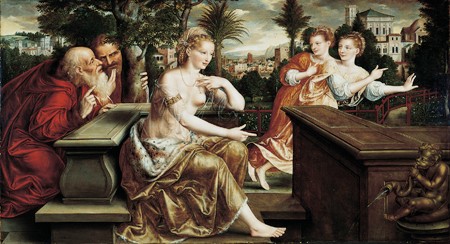Many historians have regarded Jan Massys (c. 1509–1575) as a mere follower of his father, Quentin (1466–1530), because of his total indifference to the new stylistic tendencies introduced to the Netherlands by Romanist painters. My CASVA residency offered ample opportunity to analyze Jan Massys’ depictions of female beauty, which in turn, allowed me to connect him to the cultivated milieu of the humanist academies in Antwerp and thus to assign him a distinctive place in the panorama of sixteenth-century Netherlandish painting.
Starting from his father’s models, Jan gradually introduced new aesthetic canons and endowed his female figures with a sophisticated, innovative sensuality. His idea of female beauty was conveyed by the introduction of statuesque women, often nude; sumptuous silken draperies; transparent veils; and elaborate jewelry. In addition, his painting technique and palette appear to have undergone a fundamental reconsideration to achieve a candid purity in flesh tones and new pictorial effects in such details as rich silken draperies.
Massys’ formula for the depiction of female beauty was extremely personal: unlike the crowded mythological compositions of his contemporary Frans Floris (1517–1570), his compositions include only one or a few characters, but always with a female figure at the center. No male nudes are present, and male characters are always grotesque and old, presented as antithetical to the central female protagonist. The latter, nude or partially draped, is visually isolated through her particularly white flesh tones; she appears to be indifferent to her surroundings, and she never interacts with any male figures included in the painting. She is placed in the foreground in very close proximity to the intended male viewer, in many cases smiling and peering beyond the picture plane in order to capture his attention and seduce him. Clearly, the viewer is her real interlocutor, placed in a deliberately equivocal position between voyeurism and amorous rapture. Since the viewer is the missing but implied character in the narrative, a close connection between the painter and his patrons and collectors must be postulated, with the further assumption that they must have shared cultural references and aesthetic ideals, above all, Pliny’s idea—recounted in L’Aretino (1557) by Ludovico Dolce (1508 /1510–1568)—that a perfectly executed portrait will retain the essence of a living woman, as exemplified in the anecdote of Apelles and Campaspe.
I investigated Massys’ models, particularly in connection with the tradition of erotic portraiture associated with Leonardo’s legacy and the school of Fontainebleau, such as the several versions of Monna Vanna and Flora Meretrix. Next, I focused on questions of patronage and on who among the collectors in Antwerp might have commissioned and collected paintings of this type. So far, only one of Massys’ patrons has been identified: Ambrogio Di Negro (1519–1601), a Genoese nobleman who, as I have shown in a previous study, commissioned Venus Cythereia (1561; Nationalmuseum, Stockholm). While resident in Antwerp in 1559–1560, Ambrogio combined his activities as a banker and a poet and was connected with the group of humanists there—mainly Italians and especially Genoese—who founded the Accademia
I also focused on Massys’ painting technique, specifically on his
achievement of ivory flesh tones, so consistent with Petrarchan imagery, finished with glazes of translucent lead white paint. This part of my research, focusing on color and modes of representing flesh tones, will be developed further, in relation to the critical reception of Karel van Mander (1548–1606). Van Mander’s condemnation of painters who depicted nudes with “pale, fishy, coldish color” instead of “glowing” tones may well have been a specific reference to Jan Massys.
Through my residency, supported by the exceptional resources of the National Gallery of Art Library and many helpful conversations with members of CASVA and Gallery staff, I was able to accomplish an important stage of my work on a new monograph on Massys.
